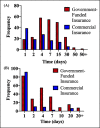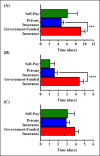Inequalities in Pediatric Fracture Care Timeline Based on Insurance Type
- PMID: 32852914
- PMCID: PMC7417144
- DOI: 10.5435/JAAOSGlobal-D-20-00111
Inequalities in Pediatric Fracture Care Timeline Based on Insurance Type
Abstract
Introduction: Socioeconomic and insurance status are often linked with limited access to health care. Despite several government-funded projects aimed at curtailing these barriers, pediatric orthopaedic patients continue to experience delays in receiving timely care for fracture treatments. This delay has been well-identified within the orthopaedic literature but, to our knowledge, has never been characterized based on timeline. Thus, the goal of this study is to evaluate the role of ethnicity, socioeconomic status, and insurance type on the timeline of pediatric patients to obtain orthopaedic care within our community.
Methods: Pediatric patients presenting to our clinic for the treatment of one of 21 most common fractures were included. Patient demographics and the timeline of patient care were collected by retrospective chart review.
Results: Government-funded insurance accounted for 60.6% of the 413 patients. These patients experienced significant (P < 0.001) delays in access to care when compared with commercial insurance patients; the time between injury and referral as well as the overall time from injury to orthopaedic evaluation was 2.8 and twofold greater at 4.4 days and 9.2 days, respectively. A strong correlation was established between income levels and insurance type.
Discussion: Pediatric patients with a lower socioeconomic status are more likely to rely on government-funded insurance and experience delays in fracture evaluation.
Conflict of interest statement
None of the following authors or any immediate family member has received anything of value from or has stock or stock options held in a commercial company or institution related directly or indirectly to the subject of this article: Dr. Kitchen, Ornell, Dr. Shah, Dr. Pipkin, Tips, and Dr. Hogue.
Figures


Similar articles
-
Race, Income, and Insurance Status Are Associated with Increased Time to Initial Outpatient Evaluation of Fracture Patients.J Pediatr Soc North Am. 2024 Jul 4;8:100070. doi: 10.1016/j.jposna.2024.100070. eCollection 2024 Aug. J Pediatr Soc North Am. 2024. PMID: 40432994 Free PMC article.
-
Socioeconomic status impacts outcomes following pediatric anterior cruciate ligament reconstruction.Medicine (Baltimore). 2019 Apr;98(17):e15361. doi: 10.1097/MD.0000000000015361. Medicine (Baltimore). 2019. PMID: 31027121 Free PMC article.
-
What's New in Pediatric Orthopaedic Health Care Disparities?J Pediatr Orthop. 2022 Oct 1;42(9):e954-e959. doi: 10.1097/BPO.0000000000002224. Epub 2022 Aug 11. J Pediatr Orthop. 2022. PMID: 35948529 Review.
-
Pediatric orthopaedic patients presenting to a university emergency department after visiting another emergency department: demographics and health insurance status.J Pediatr Orthop. 2007 Sep;27(6):690-4. doi: 10.1097/BPO.0b013e3181425653. J Pediatr Orthop. 2007. PMID: 17717473
-
Socioeconomic factors are associated with frequency of repeat emergency department visits for pediatric closed fractures.J Pediatr Orthop. 2014 Jul-Aug;34(5):548-51. doi: 10.1097/BPO.0000000000000143. J Pediatr Orthop. 2014. PMID: 24590328 Free PMC article.
Cited by
-
Racial and Ethnic Disparities in Pediatric Musculoskeletal Care.Curr Rev Musculoskelet Med. 2023 Oct;16(10):488-492. doi: 10.1007/s12178-023-09860-0. Epub 2023 Aug 7. Curr Rev Musculoskelet Med. 2023. PMID: 37548870 Free PMC article. Review.
-
Disparity in Access and Poorer Health Status in Non-Majority Populations.J Pediatr Soc North Am. 2024 Feb 12;5(Suppl 1):594. doi: 10.55275/JPOSNA-2023-594. eCollection 2023 Feb 15. J Pediatr Soc North Am. 2024. PMID: 40433595 Free PMC article.
-
Race, Income, and Insurance Status Are Associated with Increased Time to Initial Outpatient Evaluation of Fracture Patients.J Pediatr Soc North Am. 2024 Jul 4;8:100070. doi: 10.1016/j.jposna.2024.100070. eCollection 2024 Aug. J Pediatr Soc North Am. 2024. PMID: 40432994 Free PMC article.
-
Delay in Time to Physical Therapy After Orthopaedic Treatment.J Pediatr Soc North Am. 2024 Feb 5;5(4):649. doi: 10.55275/JPOSNA-2023-649. eCollection 2023 Nov. J Pediatr Soc North Am. 2024. PMID: 40432932 Free PMC article.
-
Assessment of Ethno-racial and Insurance-based Disparities in Pediatric Forearm and Tibial Fracture Care in the United States.J Am Acad Orthop Surg Glob Res Rev. 2022 Jul 29;6(7):e22.00126. doi: 10.5435/JAAOSGlobal-D-22-00126. eCollection 2022 Jul 1. J Am Acad Orthop Surg Glob Res Rev. 2022. PMID: 35908228 Free PMC article.
References
-
- Skaggs DL, Clemens SM, Vitale MG, Femino JD, Kay RM: Access to orthopedic care for children with medicaid versus private insurance in California. Pediatrics 2001;107:1405-1408. - PubMed
-
- Skaggs DL, Lehmann CL, Rice C, et al. : Access to orthopaedic care for children with Medicaid versus private insurance: Results of a national survey. J Pediatr Orthop 2006;26:400-404. - PubMed
-
- Iobst C, Arango D, Segal D, Skaggs DL: National access to care for children with fractures. J Pediatr Orthop 2013;33:587-591. - PubMed
-
- Sabatini CS, Skaggs KF, Kay RM, Skaggs DL: Orthopedic surgeons are less likely to see children now for fracture care compared to ten years ago. J Pediatr 2012;160:505-507. - PubMed
-
- Sturm JJ, Hirsh DA, Massey R, Khan NS, Simon HK: Access to outpatient follow-up orthopedic care after pediatric emergency department visits: Impact of implementation of a managed Medicaid program. Pediatr Emerg Care 2008;24:659-663. - PubMed
MeSH terms
LinkOut - more resources
Full Text Sources
Medical

